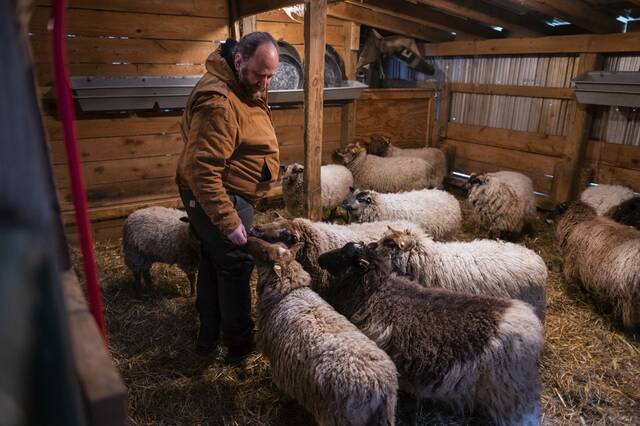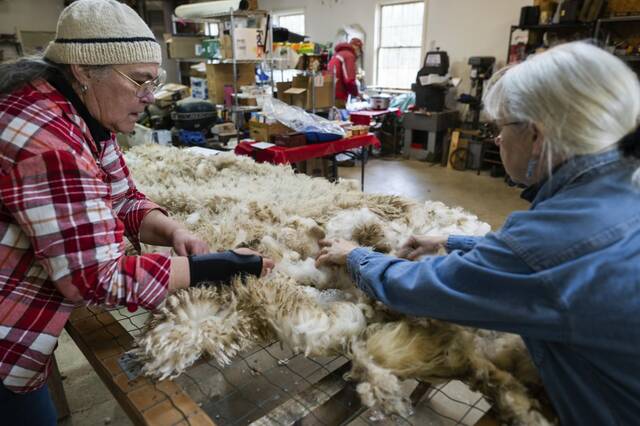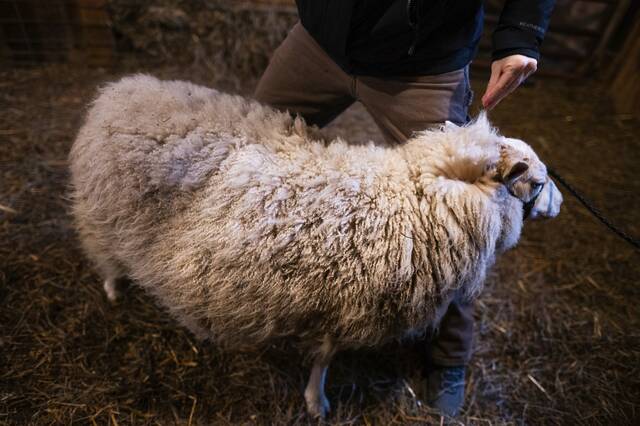From sheep to shawl: Loyalhannon Spinners keep age-old craft alive
About 10 years ago, Trafford resident and knitting enthusiast Liza Jennings Seiner began to wonder: where does yarn come from?
“I’ve been a knitter since I was a kid, and it just never occurred to me,” she said. “You can go down to Joann’s and you can buy yarn and make stuff, (but) it isn’t natural — something has to happen.”
After taking a trip to a Point Breeze craft store, Seiner returned home with her first spindle and a swatch of roving — an unspun fiber material used to spin yarn. Her first stab at using it turned out a bit chunky, but she’ll always treasure it, she says.
“I like to go back to the beginnings of things and find out where their sources are,” she said. “I was so excited, because I watched a couple of YouTube videos and some other videos, and I spun.”
Her messy first try started Seiner on a journey that would lead her to the Loyalhannon Spinners, a group of more than 30 Western Pennsylvania craftspeople who meet near Latrobe to practice the ancient art of spinning yarn. Seiner, now the group’s secretary, sends emails about monthly meetings, plans projects and keeps track of the group’s history.
Their chosen craft, spinning, can be accomplished in many different ways. Spinners can work a variety of fiber types, and Seiner says she prefers spinning cotton, a more difficult type of fiber to work.
“(Spinning) is taking an unorganized bunch of fiber and making yarn. It doesn’t have to be animal based, like sheep’s wool, (though) that’s very common,” she said. “It is just putting twists in a bunch of fibers that makes it strong. Twist is like the glue that makes the fibers strong, and make it so that you can have more than a few inches of yarn at a time.”
Spinners use varying equipment — a rock and a stick, a spindle, or a manual or electric spinning wheel. All the tools serve the same purpose of twisting the fiber, Seiner said.
“You could say there are two types of spinners. (There are) those who think of their yarn as the end of it. They just enjoy making yarn and there is no other step, it’s the making of yarn,” she said. “Then there are those who might take that yarn and knit something with it or crochet or weave or braid. There’s any number of things that people might do to make something else after the yarn.”
Spinner’s circle
The Loyalhannon Spinners group was founded in October 2001, based on a former name for the Loyalhanna Creek listed on a map in Fort Ligonier, according to co-founder and president Sandy Truckner.
Many of the group’s members are from Westmoreland County, but some hail from Allegheny and other surrounding counties. Meeting places have changed over the years, and the group originally met in members’ homes.
Beyond spinning, many members do other fiber arts, such as weaving or knitting. Spinning in particular is an especially social activity for some, Truckner said, because it doesn’t require as close of attention as compared to other activities, such as weaving.
“People love to come, and they all know each other a little bit, and they know somebody else better, it’s just a real friendly group,” she said. “We like to visit, and we like to spin.”
Truckner doesn’t spin as much these days, but she keeps around 20 sheep at her farm. Group members often use her flock’s wool for spinning, and sometimes come along to see the sheep be sheared.
“It’s sort of a large community. You’re all connected by the sheep,” Truckner said.
Competitive spinning
Spinners who spin wool yarn start with a fleece, or a mass of wool that has been sheared from a sheep. The Loyalhannon group regularly participates in “sheep to shawl” competitions, in which the whole process, from shearing the sheep to making the yarn, is done on a short time frame. At the state farm show, groups like Loyalhannon compete to make the best shawl within the time limit.
“It starts with shearing the sheep. Then, you gather the fleece up, and take it over to where your group is setting up on the arena floor,” Truckner explained. “Then, you have to card it so that it is spinnable. You spin it into yarn, and the weaver weaves the shawl. Then, the shawl is judged on all kinds of different criteria, and you have to get it into that time frame.”
The atmosphere at the competitions can be high pressure, said group member Diane Yorkshire of Plum.
“You have to bring your own sheep, you have to bring your own shearer, and you have to bring your equipment,” said Yorkshire. “You have to practice for a year. They even judge the fiber — the fiber is still warm when you are spinning it.”
Love of the practice
At the group’s regular meetings, not everyone is spinning the entire time. The group discusses plans for demonstrations and competitions, and some members work on other fiber projects, such as knitting, crocheting, weaving, quilting and felting.
“Everybody here is an artist of one kind or another,” Truckner said. “Nobody is just a spinner.”
For the spinners, making thread can be a relaxing activity, and a great creative outlet.
Deborah Hart of Whitney, a charter member of the group, originally met Truckner at an event at Idlewild Park & SoakZone. Truckner had four of her sheep with her at the event, which drew her attention, Hart said. She now works in a number of different fiber arts mediums, including felting and weaving.
“I was like a magnet,” she said. “I grew up in a house with an antique spinning wheel, it was my great-great-grandmother’s. We had to dust it, and we always thought, how does this work? I fell down the fiber hole since then.”
Another group member, Jane Phillips of Eighty Four in Washington County, raises her own alpacas.
“I have a lot of fiber, and I’m always looking for fun things to do with that,” she said, noting that alpaca wool has a different texture than sheep wool. The two are sometimes combined to make a more versatile fiber.
Group member Nancy Parris, who lives in Cheswick, started spinning around 2010 when her sister bought her a spinning wheel.
“It’s something that you can do and it doesn’t take all of your focus, necessarily,” she said. “When you’re spinning, you can be involved in conversation. …Spinning is relaxing. I have literally fallen asleep spinning.”
Being able to participate in all of the steps of the process is exciting for Parris.
“Aside from raising the sheep, I made this from the beginning,” she said, holding up a hat she made from some of the wool from Truckner’s sheep. “I was there when the sheep was sheared, and helped with that, so I’ve taken in the whole process from start to finish into a wearable garment.”
Julia Maruca is a TribLive reporter covering health and the Greensburg and Hempfield areas. She joined the Trib in 2022 after working at the Butler Eagle covering southwestern Butler County. She can be reached at jmaruca@triblive.com.
Remove the ads from your TribLIVE reading experience but still support the journalists who create the content with TribLIVE Ad-Free.














